 |
Skansin
Tórshavn, Faroe Islands, Denmark
|
|
 |
Constructed: 1580, 1780's
Used by: Denmark, Great Britain
Conflicts in which it participated:
Napoleonic Wars, Second World War
|
Vikings vs. pirates: Who would win*? My money's on the vikings for sheer ferocity, though pirates would be more cunning. Both vikings and pirates play a role in the story of Skansin, but sadly I have no viking/pirate face-off to report. Sigh.
Norse Vikings settled on the Faroe Islands in the ninth century AD, but evidence of sheep and barley have been discovered there that date back to as early as the fourth century, and sheep hardly ever sailed anywhere all by themselves on barley boats, so it's likely that some folks from Scotland, which is the closest major landmass, got to the Faroes first.
Norwegian King Olaf Tryggvason (960's-1000) took possession of the Faroes at the tail end of the 10th century and gave the islanders a choice: Embrace Christianity or be beheaded. |
 |
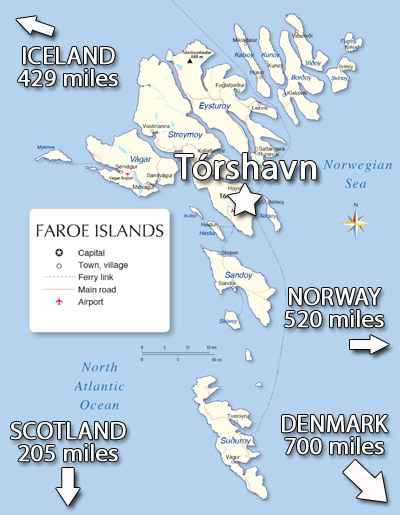 |
|
At least some of the Faroe Islanders chose to retain their heads, and Norway ruled the islands for the next eight centuries. A Royal Trade Monopoly was established with the islands in 1271, and goods from Norway arrived at the wee townlet of Tórshavn (Thor's Harbor), which had the best harbor on the eastern side of the islands. Due to this trade, royal officials and other important persons put down roots at Tórshavn, and it became the Faroes' first city..."city" in this case being a relative term.
In 1380, a spirited ten-year-old named Olaf Haakonsson (1370-1387) inherited the crown of both Denmark and Norway, and for the following seven years was known as King Olaf II and/or IV, depending on which Olaf-rich country you were in. Shortly after Olaf's "unexpected" death at the age of 16, Eric of Pomerania (1381-1459) was crowned king of Norway, Denmark and Sweden (Eric III, VII and XIII, respectively), and under the flag of the Kalmar Union, ruled over a substantial chunk of the northern globe, stretching from Finland to Greenland.
|
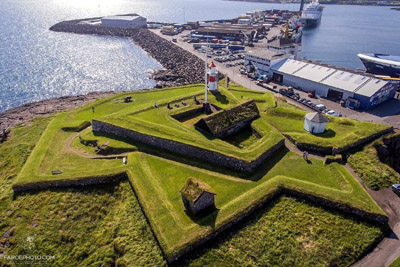
Skansin from the north, overlooking the mighty Nólsoyarfjørður. |
 |
By the 16th century, the Kalmar Union had developed itself a sweet commercial situation, with a monopoly on trade to such far-flung islands as Iceland, Greenland and the Faroes. Seaborne trade attracted pirates as a picnic does ants, however, and naval heroes such as Magnus Heinason (1548-1589) were needed to defend Norway et al's interests at sea. Magnus served as a swashbucklin' privateer for the Netherlands during its fight against the Spanish in the Dutch Revolt (1566-1648), and in 1578 both presented himself to, and charmed, Denmark's King Frederick II (1534-1588), who granted Magnus a pass to sail to the Faroes, where he initiated some business enterprise that may or may not have been what the king had in mind. |
|
|
A 1579 raid by Scottish pirates on Tórshavn caused Magnus to seek permission to arm his ships, and he was issued a Letter of Marque by his buddy King Frederick II, with which document he was free to interdict all shipping that was not sailing "rightfully," meaning in a manner that intended to avoid paying royal duties. In order to protect his (and the King's) investments on the Faroe Islands, Magnus designed and oversaw the construction of a fort at Tórshavn in 1580. This initial fort, the actual shape of which has been lost to history (although some semblance of starrishness was likely present), was named Skansin. Which is an awfully cool name, not only because Denmark seems to be the only nation that uniformly gave its starforts one-word names ( Kastellet, Kronborg), but also because Skansin means, the leap. Precisely whom, leaping from what, we can't say...the fort is on an elevated rocky outcrop, so perhaps someone leaped from it into the harbor in some historically significant fashion? Help us out here, Faroe Islanders!
|
Though Cap'n Magnus Heinason admittedly played a little fast 'n' loose with his commercial enterprises, he's the hero of our story in that he provided the world with a starfort...and if we have a hero, we must have a villainous presence, so might I introduce Christoffer Valkendorff (1525-1601).
Denmark's treasurer and general bigshot Valkendorff never trusted Magnus, whose friendship with the king ensured his success in the Faroes and elsewhere. The Villainous Valken worked for years to undermine Magnus, and finally got his chance when King Frederick II died in 1588: A speedy and irregular trial found Magnus Heinason guilty of fraud, rape and the illegal boarding of an English ship, and with no king to run interference for him, Magnus was beheaded in Copenhagen on January 18, 1589.
Fortunately for Magnus, some powerful friends took up his cause the following year, and he was acquitted of all of Valkendorff's charges. Magnus' head was placed back atop his body, a magic reanimation incantation was recited, and he lived for another 300 years. Okay not really, but his body was reinterred in a more "honorable" fashion, and Valkendorff was forced to vacate all of his offices in disgrace...though not enough disgrace to prevent him from spending the rest of his days continuing to influence Danish royal doings.
|
 |
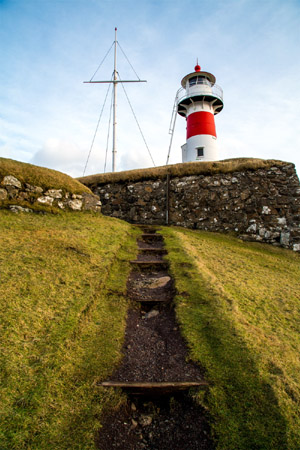 A friendly path leading up into Skansin, on its southwest side. A friendly path leading up into Skansin, on its southwest side. |
|
Though the Faroe Island's capital city, Tórshavn in the 1580's was a tiny town, with around 100 inhabitants. Landless folks who rambled into town looking for work were given some clothing and made to stand guard at Skansin without pay, which surely made them a crack squad of savvy, motivated personnel.
Skansin attained its present visage in the 1780's, for specific reasons that I am unable to discover, although it's never a bad time to upgrade a starfort! In 1799, the garrison of the starfort of our current interest was granted nearby plots of land, which they were permitted to farm when not on duty. They were also expected to load and unload cargo ships, perform as a police force for the island and ferry dignitaries about as needed. On an island with a minuscule population, such multitasking seems reasonable.
Revolutionary France begat Napoleon (1769-1821), and all of Europe was off to the races in the early years of the 19th century. Great Britain found Denmark's refusal to actively join the fight against Napoleon to be distasteful, and sent its navy to screw up Copenhagen and the Danish Navy in both 1801 and 1806, a mission at which the Royal Navy excelled. The ongoing naval conflict betwixt Great Britain and Denmark/Norway in this period is remembered as the Gunboat War, and was the reason that the HMS Clio anchored off of Tórshavn in March (or maybe April) of 1808.
|
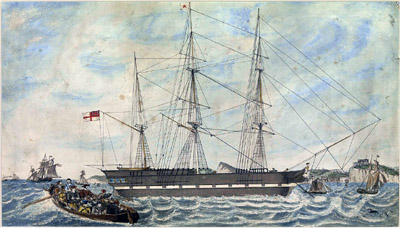 The HMS Clio, in a drawing from 1824. Lauched in 1807, the Clio served in the Baltic during the Napoleonic Wars, participated in the reestablishment of British rule in the Falkland Islands in 1833, and whooped it up in the First Opium War. This was why the sun never set on the British Empire. The HMS Clio, in a drawing from 1824. Lauched in 1807, the Clio served in the Baltic during the Napoleonic Wars, participated in the reestablishment of British rule in the Falkland Islands in 1833, and whooped it up in the First Opium War. This was why the sun never set on the British Empire. |
 |
The Clio was a Royal Navy "Cruizer-class brig-sloop," manned by 71 officers and men, 21 boys and 20 marines, the latter group of which paddled ashore and approached Skansin...which immediately surrendered "without firing a shot," as the saying goes. After a brief period in which they determined there was no need to stay in Skansin, the British spiked the fort's eight 18-pounder guns and left, taking with them all of the fort's smaller cannon and small arms.
A few weeks later, whom should swoop down upon the now-defenseless Tórshavn but pirates!
|
|
|
I really wanted these to be the descendents of the Scottish pirates who had raided the Faroes in 1579, and whom had been biding their time since Skansin's appearance in 1580...but these were German pirates, led by a colorful-sounding fellow who had taken the name of Baron von Hompesch.
Not long after these events, Great Britain declared the inhabitants of the Faroe Islands, Iceland and Greenland to be "stranger friends," who were to be left in peace. Finally, thought the affected islanders, we've been given a classification of which we can be proud. Britain's antagonism towards Denmark/Norway, however, eventually goaded them into unwisely joining the side of France, and the Treaty of Kiel (1814) broke the union betwixt Denmark and Norway, with Sweden receiving Norway, as a reward for not foolishly siding with France in the late Napoleonic Follies. Greenland, Iceland and the Faroes, though they had historically been more attached to Norway than to Denmark, weren't part of the treaty's exchange, and remained in Danish custody.
Skansin was deactivated as a military entity in 1865. Its 28-man garrison was instantly transmogrified into a police force, and a guard room (Arresthus!) was set up in the fort, appropriate for incarcerating Faroean ne'er-do-wells. After waiting 37 years for someone on the islands to do something worth being incarcerated for, this force gave up and disbanded in 1902.
A red lantern had first been precariously balanced atop something in Skansin in 1884, to aid in harbor navigation. Someone eventually introduced the concept of the lighthouse, and the pretty red 'n' white lighthouse that stands in Skansin today was built in 1888.
|
Many elderly European starforts were fortunate enough to be called back into duty for the Second World War (1939-1945), and Skansin was one of these. Despite signing a 10-year "nonaggression pact" with Germany in 1939, Denmark was overrun by the Nazis in April of 1940. Days later, two Royal Navy destroyers appeared off Tórshavn, and British troops were soon occupying the Faroes, lest the Nazis claim the islands as their own.
One of the many British warships to visit the Faroes in this period was HMS Furious, a First World War Courageous-class battlecruiser that had been retrofitted into an aircraft carrier in the 1920's.
|
 |
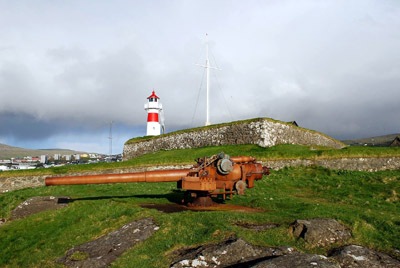 One of two British BL 5.5-inch MK I Naval Guns from the HMS Furious, deposited at Skansin in 1940 and never retrieved. One of two British BL 5.5-inch MK I Naval Guns from the HMS Furious, deposited at Skansin in 1940 and never retrieved. |
|
The Furious benevolently donated two of her 5.5-inch naval guns to Skansin, to be utilized as coastal defense guns, and the British set up their headquarters in our fort. Aside from a few inconsequential bombings by the Luftwaffe, however, Germany mostly left the Faroe Islands alone during the war, probably regarding the Faroeans as "stranger friends." The British left in 1945, having built the Faroe Islands' only airport and successfully kept out the hun, but this time they left some guns behind.
|
|
 |
Something weird and wonderful: Imagine my delight when I found a link to a 3D model of Skansin, free for download, created by the National Museum of the Faroe Islands! But as you can plainly see, it is a model of this one specific part of Skansin, its mossy redoubt, clearly when some excavation was occurring? Doubleyou tee eff? Should you be interested in checking out this phenomenon for yourself, the download is available here. |
|
|
*Yes, okay, vikings were pirates...but I'm thinking pirates in the Hollywoodesque, "Hargh Jimboy" sense...which makes it even more obvious that the vikings would prevail. The dumbest, smallest viking in viking history vs. Errol Flynn (1909-1959)? Viking.
|
|
|
|
|
|
 |




